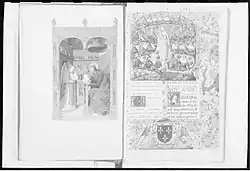| New Testament manuscript | |
 | |
| Text | Gospels |
|---|---|
| Date | 15th-century |
| Script | Greek-Latin diglot |
| Now at | National Library of France |
| Size | 30.9 cm by 21 cm |
| Category | none |
| Hand | elegantly written |
| Note | close to minuscules 30, 70 |
Minuscule 17 (in the Gregory-Aland numbering), ε 525 (Soden).[1] It is a Greek-Latin minuscule manuscript of the New Testament, on 354 parchment leaves (30.9 cm by 21 cm), dated palaeographically to the 15th century (according to Scrivener 16th-century).[2] It has some marginalia.
Description
The codex contains a complete text of the four Gospels on 354 parchment leaves. The text is written in two columns per page, 25-26 lines per page.[2][3]
The text is divided according to the Ammonian Sections, whose numbers are given at the margin. It contains lectionary markings at the margin (for liturgical use), Latin Synaxarion, and pictures.[4]
It contains the Latin Vulgate version.
Text
Aland did not place the Greek text in any Category.[5] According to the Claremont Profile Method in represents textual family Kx in Luke 1 and Luke 20, in Luke 10 no profile was made.[6]
It creates the textual cluster 17 along with manuscripts 30, 70, 120, 287, 288, and 880. Among these manuscripts 30 and 288 form pairs.[7]
In Matthew 1:11 it has additional reading τον Ιωακιμ, Ιωακιμ δε εγεννησεν (of Joakim, and Joakim was the father of). The reading is supported by Codex Campianus, Koridethi, manuscripts of the textual family f1, 33, 70, 71, and 120; the reading was cited by Griesbach in his Novum Testamentum Graece.[8][9]
History
"It was neatly written in France by George Hermonymus the Spartan, who settled at Paris in 1472, and became the Greek teacher of Budaeus and Reuchlin".[10]
It once belonged to Cardinal Charles de Bourbon (1476-1488). It was examined by Wettstein, Griesbach,[11] Scholz, and Henri Omont. C. R. Gregory saw the manuscript in 1885.[4]
It is currently housed at the Bibliothèque nationale de France (Gr. 55) at Paris.[2][3]
See also
References
- ↑ Gregory, Caspar René (1908). Die griechischen Handschriften des Neuen Testament. Leipzig: J. C. Hinrichs'sche Buchhandlung. p. 48.
- 1 2 3 Aland, K.; M. Welte; B. Köster; K. Junack (1994). Kurzgefasste Liste der griechischen Handschriften des Neues Testaments (2 ed.). Berlin, New York: Walter de Gruyter. p. 47. ISBN 3-11-011986-2.
- 1 2 "Liste Handschriften". Münster: Institute for New Testament Textual Research. Archived from the original on 2018-02-20. Retrieved 2014-01-31.
- 1 2 Gregory, Caspar René (1900). Textkritik des Neuen Testamentes. Vol. 1. Leipzig: J.C. Hinrichs’sche Buchhandlung. pp. 132–133.
- ↑ Aland, Kurt; Aland, Barbara (1995). The Text of the New Testament: An Introduction to the Critical Editions and to the Theory and Practice of Modern Textual Criticism. Erroll F. Rhodes (trans.). Grand Rapids: William B. Eerdmans Publishing Company. p. 138. ISBN 978-0-8028-4098-1.
- ↑ Wisse, Frederik (1982). The Profile Method for the Classification and Evaluation of Manuscript Evidence, as Applied to the Continuous Greek Text of the Gospel of Luke. Grand Rapids: William B. Eerdmans Publishing Company. p. 53. ISBN 0-8028-1918-4.
- ↑ Frederik Wisse, The Profile Method for the Classification and Evaluation of Manuscript Evidence, as Applied to the Continuous Greek Text of the Gospel of Luke, William B. Eerdmans Publishing, (Grand Rapids, 1982), p. 95.
- ↑ Eberhard Nestle, Erwin Nestle, Barbara Aland and Kurt Aland (eds), Novum Testamentum Graece, 26th edition, (Stuttgart: Deutsche Bibelgesellschaft, 1991), p. 4. [NA26]
- ↑ J.J. Griesbach. Novum Testamentum Graece. Vol. 1. p. 4.
- ↑ Scrivener, Frederick Henry Ambrose; Edward Miller (1894). A Plain Introduction to the Criticism of the New Testament. Vol. 1 (4 ed.). London: George Bell & Sons. p. 193.
- ↑ J. J. Griesbach, Symbolae critiquae, p. CLII
Further reading
- Gregory, Caspar René (1900). Textkritik des Neuen Testamentes. Vol. 1. Leipzig: J.C. Hinrichs’sche Buchhandlung. pp. 132–133.